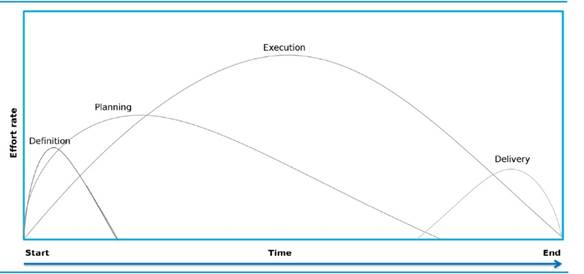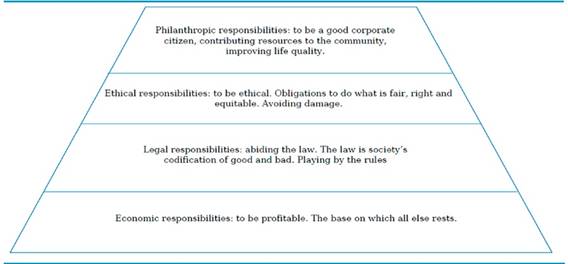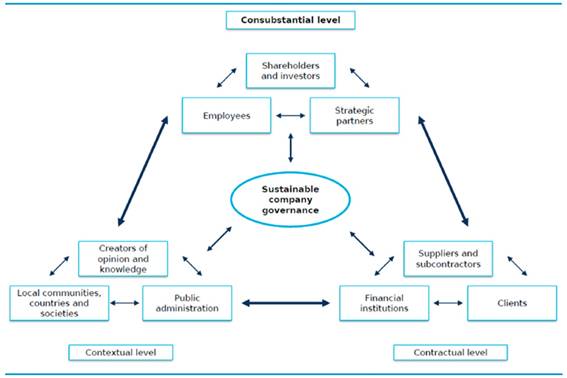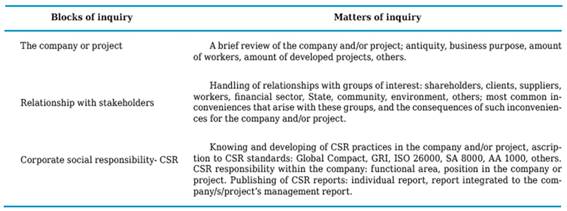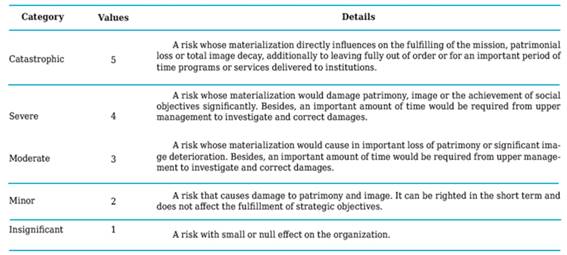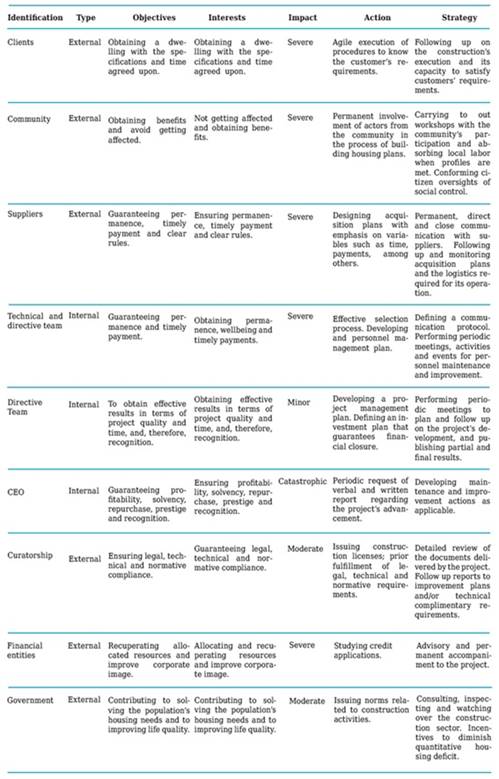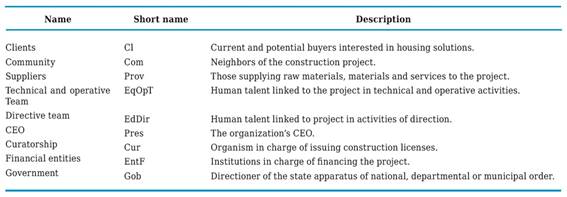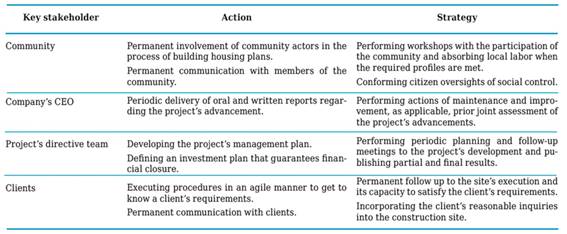1. Introduction
Governability, management of environmental and social impacts, accountability to stakeholders and alliances for strategic development are the main attributes making up Corporate Social Responsibility- CSR- according to Vallaeys, De la Cruz and Sasia (2009). Project management (PM), in turn, bears the responsibility of ensuring that the project’s objectives be achieved with quality, within budget, on time and to the client’s and other stakeholders’ full satisfaction (Gido and Clements, 2012). These, in turn, are any group or individual who may affect or be affected by the achievement of the organization’s objectives (Argandoña, 2010).
This way may be affirmed that stakeholders’ management is a common element between CSR and PM as they share an orientation towards particular interests and customer satisfaction. Nonetheless, the exercising of the former has been focused on minimizing perils derived from the dissatisfaction of the project’s stakeholders’ interests. About this, the Project Management Institute (PMI) (2013, p. 390), for instance, suggests that:
Interested parties management is also centered on continuous communication with interested parties in order to understand their needs and expectations, approaching issues the moment they occurs, managing conflicts of interests and promoting interested parties adequate participation in decision making and the project’s activities.
Regarding the sector of construction, in addition to its importance and contributions to national economy (CAMACOL Tolima, 2015; Departamento para la Prosperidad Social (DPS), Programa de las Naciones Unidas para el Desarrollo PNUD, 2013), its business model consists on working by projects which require effective leading, including the responses the sector’s companies must provide in social, environmental and economic terms in order to satisfy its stakeholders’ interests with the expected benefits such as improvement on corporate image, costs saving and the reward from its clients.
By the foregoing, knowing who its stakeholders are, what are their rights and interests and what implications and impact they might have on a project turns imperative for the sector’s appropriate functioning, in order to plan and execute strategies and actions that allow to satisfy them and minimize the project’s hazards.
Thusly, this paper’s aim is to present the analysis of housing projects’ stakeholders based on an international scale methodology. Hence, this works offers several contributions: 1. For the housing construction sector, it may understand systematically its different interested parties and thus improve the management of its relationships; 2. Methodological, by applying the set of matrixes and analysis to a particular case; 3. For researchers, academic communities, universities and the general community interested on the subject.
Next on, the reader shall find the applicable theoretical framework with the topics of PM, CSR and stakeholders’ management; the methodology employed thereafter, then the results and their discussion; and, finally, conclusions and related recommendations.
2. Theoretical Framework
2.1. Project Management
Projects have their own characteristics that make them different to permanent organizations. These characteristics are incorporated to the management of projects which “recognizes the reach, cost and time of a project to three great opportunities of attaining an advantage for the success of the projects” (Torres and Torres, 2014, p. 9).
Reach refers to deliverables required by the customer or owner of the project, which to a great extent mean their satisfaction; besides, it “leads to complying with required costs and time” (Torres and Torres, 2014, p. 9). These correspond to those commitments to budget and duration agreed upon with the client or the owner of the project.
In order to meet this challenge is imperative the participation of a project manager who “performs the same tasks as other managers” (Gray and Larson, 2009, p. 8): he plans, programs, coordinates and controls; but bearing special characteristics derived from the peculiarities of projects like the administration of normal non-repetitive tasks with (generally multidisciplinary) teams formed as a response to the projects’ requirements, by means of ad-hoc efforts with a defined life cycle, that end when performance objectives are successfully met (Cleland, 2001).
Arboleda (2013, p. 13), in the same vein, associates project management to the different stages of the administrative process when stating that “it is the application of techniques, tools and procedures to planning, directing, coordinating and controlling of pre-stablished goals of reach, cost, time and quality of the project at hand”, which is in agreement with Gido and Clements (2012, p. 14) who propose that “the administration of projects is the planning, organizing, coordinating, directing and controlling of resources in order to meet the projects objectives”.
In the PMI’s (2013, p. 5) concept “leading projects is the application of knowledge, skills, tools and techniques to the project’s activities in order to fulfil the requirements thereof”, which agrees with the ISO 21500 (Icontec, 2014) guideline which proposes applying methods, tools, techniques and competencies to a project, and includes the application of several stages of the project’s life cycle performed by means of processes.
Gido and Clements (2012) incorporate the concept of process, pointing to it having two grand stages: “firstly, stablishing a plan and then carrying it out to achieve the project’s goals” (p.15), which has been integrated into the project’s life cycle (Figure 1).
The different stages of a project demand different rates of effort from management and its project team. As can be seen, the first stage defines specifications and aims, and stablishes the tasks to be carried and those responsible for them. The second stage increases the effort and develops plans related to different variables of the process. Through the third stage, efforts (mental and physical) reach their top level: the product is elaborated, measurements are carried out and adjustments performed; during the fourth stage, effort decreases: the product is delivered to the client and resources are deployed.
Miranda grants this concept a broader connotation by proposing it as an organizational and executive model, according to the following statement:
Because of the magnitude of the investments, multiple and diverse interests moving, the amount of contractors and sub-contractors participating in it who determine frequent and confusing conflicts, because of the expectations created in potential users or consumers and the need to leave proprietors satisfied, for the execution stage is imperative to design and articulate into it an organizational and executive model of special relevance known as Project Management or Project Administration (Miranda, 2012, p. 15).
Project management has been permeated by organizational theories and administrative philosophies, incorporating topics like roles and responsibilities, organizational structures, delegation and corporate profitability (Kerzner, 2013), aside from juridical aspects, personal skills, software and specific technical recognition (Roessler, 2015).
At the same time, standards such as the Project Management Body of Knowledge (PMBOK) and Project In Controlled Environment (PRINCE2) 2 have risen, geared towards stablishing practices that permit to normalize project leading and organize in different categories the different activities carried out to successfully undertake a project. These are the most used standards around the world, the first one in the USA and America and the second one in England and Europe.
2.2 Corporate Social Responsibility
CSR is a concept that has evolved though time based on the views from different authors: Atehortúa (2008) opines that there’s little discussion on the subject; in turn, Hoffman (2007) and Frederick (1994) agree that modern CSR arises from 1920; by the 1970s, Friedman proposed (Bower, 1995) that businesses only have one social responsibility: employing its resources and undertaking activities routed to augmenting its profits; an economic conception centered on the company’s shareholders. To it, Carroll (1979) adds society’s expectations in the legal, ethical and discretional fields.
Freeman (1984), in contrast to Friedman’s statement, underlines that companies also have responsibilities with all the individuals that affect or who are affected by the activities it carries out to achieve its objectives. Thus, the concept of CSR, through time, has been framed into the following generations and characteristics (Table 1).
CSR centers, then, on an organization’s decisions and doings, which is why it’s worth retaking what the Centro Colombiano de Responsabilidad Social (CCSR) (2008) expressed as it affirms that a company is socially responsible when its actions are aimed at satisfying the requirements of all its interest groups, as well as taking care of and preserving the environment.
But, how could such organizational actions be understood? About this, Cadbury (2006) has defined three levels of corporate social responsibility, to wit:
Primary level is that where the company commits to fulfilling its basic responsibilities of remunerating its employees, paying suppliers and reimbursing received loans, remunerating its shareholders, etc. In the secondary level, companies must concern themselves with the environmental impacts produced by their activity and avoid environmental damage. Not only do minimum requirements need to be fulfilled, something more mist be attained. Finally, the tertiary level is where a company must ask itself about how to positively influence the society it operates in (p. 12)
On the other hand, Carroll (1991) stablished the concept of the CSR pyramid (Figure 2) where he proposes four types of responsibilities that businessmen must possess: economic, juridical, ethic and philanthropic.
Finally, Acuña, Araque, Rosero, Rubio and Uribe (2014) conclude that CSR is a set of activities or actions a company carries out in order to respond to its stakeholders and, at the same time, present results not only in the economic or financial scope but in the social and environmental fields.
2.3 Stakeholders’management
Introducing the concept of stakeholders mainly served to break the dominant thesis that companies exist to maximize benefits, or better yet, to maximize value for the proprietary (Argandoña, 2010).
Stakeholders are “those groups without whose support an organization would cease to exist” (Friedman and Miles, 2006, p. 4). They have specific interest in the organization and exercise power over it to satisfy them (Johnson, Scholes and Whittington, 2014). This term “refers to an individual or group that makes part of an organization or has a bet or interest in it” (Duque, 2009, p. 29). The same author makes a compilation of the term over time, pointing to the debate that arose from its appearance (Friedman and Miles, 2006; Wolfe and Putler, 2002); the expression of four points of view about his theory (Donaldson and Dunfee, 1994; Freeman, 1994; Donaldson and Preston, 1995; Friedman and Miles, 2006; Hendry, 2001); the identification of eight stakeholders for a business organization (Friedlander and Pickle, 1968); the classification of internal and external ones (Bounds, Yorks, Adams and Ranney, 1994); the balance between stakeholders (Anderson, 1982); the customer as the main stakeholder (Daft, 1992); the stakeholder graphic model (Freeman, 1984; Fassin, 2008); among others.
The Instituto de Estudios Superiores de la Empresa (IESE) (2002) classifies stakeholders into three levels: consubstantial, contractual and contextual. The first ones are those stakeholders without which a company’s existence would be impossible; contractual stakeholders correspond to those with whom the company has some sort of formal contract; the contextual ones are those who perform a role in achieving the organization’s credibility and the acceptance of its activities. Figure 3 elaborates on these levels.
Kerzner (2001) classifies stakeholders into three categories: financial (shareholders, financial institutions or capital suppliers, and creditors), product/market (clients, suppliers, competitors, unions, governmental agencies and local government committees) and organizational (official executives, board of directors, employees in general, and administrators). He also adds that efforts must be geared to the best interests of all the stakeholders of the organization, not only to some of them since “all companies have interested parties” (Kerzner, 2013, p. 1.108).
Navarro (2008), in turn, stablishes a classification into two large groups: internal ones, linked directly to the company or organization, whether as shareholders, partners, heads, unions, workers, strategic partners, etc. And external ones; groups of interest not organically linked to the company such as authorities, pressure groups, NGO, competitors, consumers, etc.
Now, regarding projects, it’s imperative to recognize that these “often have a lot of interested parties, several of them carrying contradictory objectives”3 (Morris, 2009, p. 141), but their correct management must be routed to delivering satisfaction to customers/sponsors (Morris, 2009; Morris, 2013), and fulfilling or exceeding the strategic goals set forth (Morris, Patel and Warne, 2000).
The important thing about defining who an organization’s stakeholders are, is that it is the first step for it to identify the each one’s main interests. If these are not known, it wouldn’t be possible to implement CSR because its essence is developing a set of practices in order to achieve stakeholder satisfaction.
3. Method
This paper is based on an explicative4 and descriptive5 research with a mixed research approach. Nevertheless, for this paper’s purposes, we only turned to the qualitative approach since this research produces descriptive data: people’s own words, either written or spoken, and observable behaviors” (Rodríguez, Gómez and Gil, 1996, p. 33). This is how “the qualitative paradigm is associated to interpretative epistemology, centered on the individual subject and the discovering of meaning, motives and the intentions of its actions (Cea, 2001, p. 46). This type of research includes images, narrations or verbalizations from the actors (Pereira, 2011); but ultimately, its design is open and flexible in order to adjust to the subject under study and the conditions surrounding it (Salgado, 2007). The design employed was phenomenological, which in the words of Hernández, Fernández and Baptista, 2014 has the “principal purpose of exploring, describing and understanding people’s experiences with regard to a phenomenon and discovering common elements in such experiences” (p. 493), which paves the way to carrying out the analysis on construction projects stakeholders.
With the purpose of obtaining information, semi-structured interviews were used as the primary instrument of recollection; these were applied to managers from the construction sector. This instrument contributes to attaining a greater understanding of people’s meanings and experiences, a key aspect for the qualitative approach (Hernández et al., 2014). Documentary analysis was employed as a complimentary technique in order to expand the information that served as the basis to carry out the proposal. This kind of analysis is geared towards “knowing what other scientific peers have done or are doing in their specific fields (…) and, lastly, to knowing the fullness of relevant information that exist about a specific subject” (Vickery, quoted by Peña and Pirela, 2007, p. 58).
The stages followed in developing this paper begin with documenting references on the topics contained in the theoretical framework; subsequently follows the designing, testing and applying of a semi-structured interview to construction companies and/or housing construction projects managers. Then, the methodology proposed by Bourne (2013) was employed with the adaptations applicable to this case and the application of the structural analysis model (Godet, 1993) so as to prioritize stakeholders, which (methodology and model) will be detailed in the next section.
4. Results
With the purpose of deepening in the knowledge of the sector and the way in which housing companies and construction projects relate to their stakeholders and approach was made with managers housing construction sector or housing construction project managers by using the semi-structured interview technique6. The interview’s guide structure will be presented in Table 2.
A pilot test was carried out, based on which was added the affair of inquiring about the consequences of the inconveniences that take place with stakeholders. The sample to apply the interview was defined by the convenience and judgement method, taking into account the interviewees meeting the previously defined role as well as counting with at least four years of experience in construction activities. The interviewees’ companies are between 4 and 37 years old; in most cases they have capitalized on the experience of some of their partners, who have been in the sector for a longer time, generally entailed to a large related company.
The development of the analysis is grounded in the interviews’ second block of inquiry, whose results allowed to identify stakeholders and their interests, as well as additional risks associated to the planning of their response. The foregoing based of the statement made by Biodiversa (2013, p. 2): “to identify stakeholders is necessary to consider all people, or groups, affected by, having influence on, or having an interest in” the organization.
The process carried out takes into consideration the first three steps stablished in the Stakeholder Circle methodology proposed by Bourne (2013), it was complimented with matrixes aimed at systematizing the related information and fed by the usage of the MicMac7 operational software from the structural analysis model designed by Godet (2001). Thusly, the identification, prioritization and visualization of housing construction projects stakeholders is carried out.
This line of thinking agrees with Morris and Baddache (2012, p. 9) who state that “stakeholder mapping is a collaborative research process of debate and discussion drawn from multiple perspectives in order to determine a key list of stakeholders through the full scope of them” for which four stages must be executed: identify, analyze, map out and prioritize. The first one lists groups, organizations and relevant people; the second one understands the stakeholder’s perspective and relevance; the third stage visualizes relationships with objectives and other stakeholders; and the fourth stage classifies the stakeholder’s relevance and identities problems.
Next on, the identification of stakeholders will be presented (Table 3), prior assessment of the impact (Table 4) for which the interests and rights of each one, the implications of their dissatisfaction, the impact on the project and the source of contact have been defined.
Table 4 Consolidated matrix of identification of housing construction projects
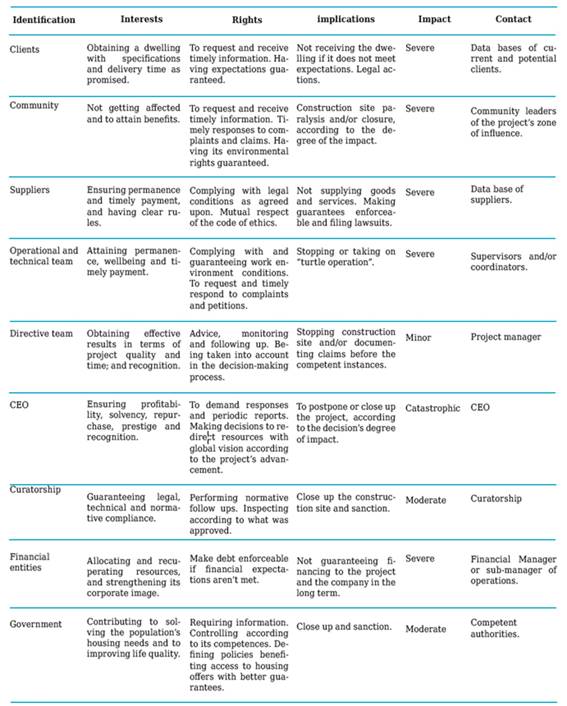
Source: Author’s own elaboration
As evidenced, most stakeholders would generate high impact on the project, except the company’s CEO whom by his role has the power to postpone or close up a project, generating a catastrophic impact. Likewise, the directive team is differentiated whom by the characteristics of its tasks and interests as a group, would generate a minor impact on the project.
Based on the results of the identification matrix, proceeds the elaboration of the risk and response planning matrix (Table 5), which is part of prioritization (Bourne, 2013) or the stage of identification suggested by Morris and Baddache (2012). In this case, the type of stakeholder is added (internal or external, following the classification suggested by Navarro, 2008), the objective derived from his interests, and the proposal of actions and strategies to face them and in two-way satisfy said interests.
With the purpose of prioritizing stakeholders (Bourne, 2013; Morris and Baddache, 2012) a structural analysis was carried out8, incorporating the dependency/influence relationship of said interested parties. Table 6 presents the configuration of the input variables entered into the MicMac.
Its goal is to show the structure if the relationships between the qualitative variables, whether quantifiable or not, characterizing a system (Godet, 1993). Said relationships are qualified in terms of influence (motivity) and dependency.
To carry out the structural analysis, different stakeholders were taken and their dependency/influence relationship was stablished. The scale of assessment is the following: 0: there is no influence; 1: low; 2: medium; and 3: high. Table 7 displays the scores given, where the analysis goes from the column towards the line, with the question: to what extent does each stakeholder in the column influence the behavior of the stakeholder in the line?
Table 7 Matrix of relationships between housing construction projects stakeholders

Source: author’s own elaboration resulting from the MicMac software.
Based on the foregoing scores, the Direct Influence Matrix (DIM) was obtained (Figure 4), which provides the state of the stakeholders’ relationships in the short term. In this matrix, influence is represented on the axis of the ordinate, and the dependency on the abscissa’s.
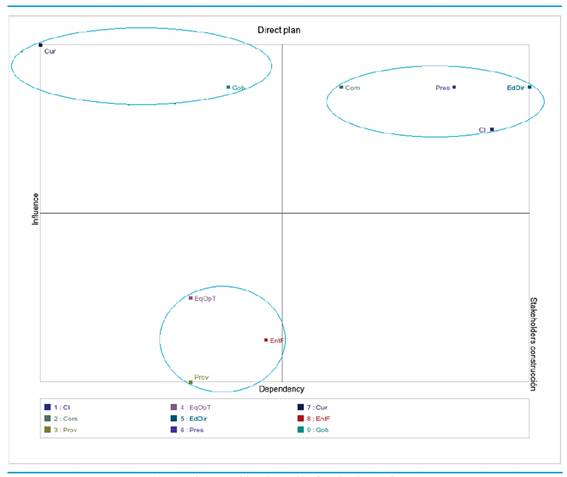
Figure 4 DIM housing construction projects stakeholders. Source: author’s own elaboration resulting from the MicMac software.
Following Garza and Cortez (2011), elements presenting high dependency and high influence, situated in the upper right quadrant, are called key variables; those located in the upper left quadrant, displaying high influence and low dependency, are deemed determining variables; those having high dependency and low influence located in the lower right quadrant are known as resulting variables; and those resulting in the lower left quadrant, with low dependency and low influence, receive the name of autonomous variables.
According to the previous figure, the stakeholders observed to have the greatest dependency/influence relationship (key stakeholders) are: the community, the company’s CEO, the directive team and customers.
Next, the long-term analysis will be carried out, which is obtained from the Indirect Influence Matrix (IIM). When running the application with the data established in Table 7, the number of recommended iterations to reach stability is found to be four for a size 9 matrix, and a measurement of influences to 100% and dependencies to 100%. This is observed in Figure 5.
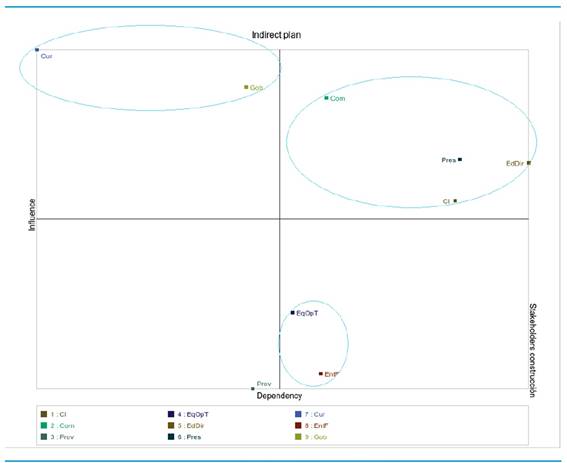
Figure 5 IIM housing construction projects stakeholders. Source: author’s own elaboration resulting from the MicMac software.
As can be seen in this figure, priority stakeholders are still the same ones found in the DIM; namely, in the long term the dependency/influence relationships between these stakeholders are kept.
Finally, it is important to observe how different stakeholders move, from the short (DIM) to the long term (IIM), according to the dynamic of the structural analysis performed based on MicMac. This situation is shown in the Displacement Plane (DP) (Figure 6).
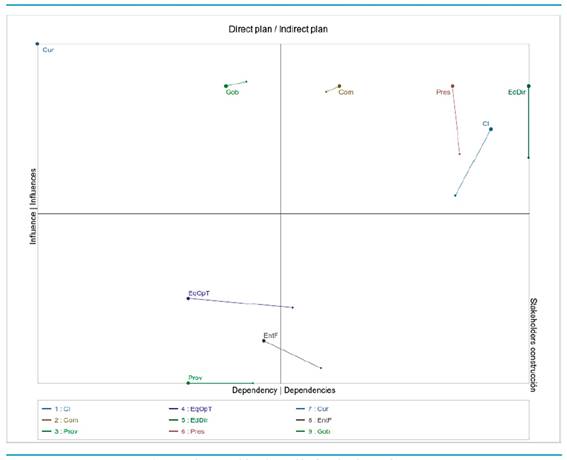
Figure 6 DP of housing construction projects stakeholders’ structural analysis. Source: author’s own elaboration resulting from the MicMac software.
It is possible to appreciate that despite there being displacements with regards to the dependency/influence of different analyzed stakeholders, in the case of the four that were prioritized, deemed as key (a little less than half of the total), they hold the same quadrant, which shows high dependency and high influence.
According to the characteristics of the structural analysis (Deusto, n.d.), the stakeholders found to be determinant are the curatorship and the government; namely, the legal-normative system that must be complied with prior to initiating the housing construction project’s execution. In turn, autonomous stakeholders are the operative and technical work team, financial entities and suppliers, who perform specific roles within a project as mentioned.
Key variables’ characteristics is that they have high motivity and are very dependent, they might disturb the system’s normal behavior, have high instability and must continuously bear the change of the system towards an optimal level (Garza and Cortez, 2011). By the foregoing, it is important to establish specific actions and strategies for this set of stakeholders (Table 8).
5. Discussion
According to the inquiry performed, it is possible to interpret that companies and projects in the construction sector, in general terms, classify within the first generation of CSR according to Freeman’s (1984) statements, since its characteristics point to low-scale development with a short-term vision; it is based on actions of philanthropy carried out to contain the reaction of one or several stakeholders, based on short-term risk management.
The stakeholders identified for construction projects are: clients, community, suppliers, operative and technical team, directive team, CEO, curatorship, financial entities and the government. According to the methodology employed, key stakeholders are: community, CEO, directive team and clients.
These key stakeholders result from the short and long term analysis, and despite there being displacements in the dependency/influence relationships of each one of them, they all remain in the key variables quadrant (High dependency and high influence).
In the classification stablished by Navarro (2008), key stakeholders fall within the categories of external (community and clients) and internal (CEO and directive team). If the IESE’s (2002) classification is followed, three levels are found: consubstantial (CEO and directive team), contextual (community) and contractual (clients). Regarding Kerzner’s (2001), there are product/market (clients) and organizational (CEO and project’s directive team); the community doesn’t match any of his categories clearly.
Regarding the rest, the following classification was found: determining stakeholders, curatorship and government; autonomous, operative and technical work team, financial entities and suppliers with regards to the short term analysis. In the long-term analysis, determining stakeholders are kept, but there are modifications in the other two cases: suppliers appear as autonomous; and operative and technical team and financial entities as result. This means, there are displacements for the operative and technical team, and financial entities.
6. Conclusions and recommendations
One of the main elements linking PM to CSR is stakeholder management, which turns evident in the literature applicable to both topics. From this common element, it is possible to set a proposition to maximize the satisfaction of these interested parties (CSR) and diminish the risk rate for the project (PM).
Identifying its stakeholders, as well as understanding their interests, is fundamental for the housing construction sector and, specifically, the management of its projects, to optimize the management of its interested parties with the purpose of meeting its objectives in terms of reach, budget, schedule and quality, on one hand; and have them completely satisfied with the purpose of improving its corporate image, save on costs, and improve repurchase index from its clients, on the other hand.
The utilization of the structural analysis methodology and the MicMac software, taken from prospective, allows to find (prioritize) construction projects’ key stakeholders, in the short term (by means of the Direct Influence Matrix-DIM) as well as in the long term (Indirect Influence Matrix-IIM) and to review its consistency (by means of the Displacement Plane-DP). Hence, the utilization of this software is recommended in order to advance stakeholder analysis.
It is important to stablish specific actions and strategies in order to manage each key stakeholder, since their high mobility and high dependency character might cause disturbances to the system’s balance, and due to high instability they require permanent challenges that contribute to optimizing the system they are a part of; in this case, a housing construction project.
Carrying out future studies is recommended so as to allow the incorporation, by using the methodology employed, of multistakeholders analysis which enables the reviewing of relationships, not only from the sector to each stakeholder, but also those that jointly spawn between the sector and them.













